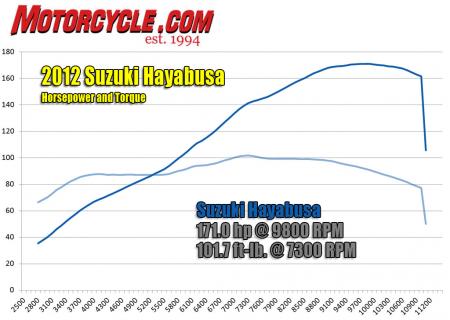2012 Suzuki Hayabusa LE Review - Motorcycle.com
By now you’ve probably seen our picks for Best Motorcycles of 2012, which means you already know our highest honor, Motorcycle of the Year, belongs to the new Kawasaki ZX-14R. This is great news for Kawi fans, but loyal MO fans and fellow speed freaks will know we still have high praise for the ZX-14R’s bitter rival, the Suzuki Hayabusa. For 2012, ‘Busa diehards have one more thing to rejoice about: the Hayabusa Limited Edition (LE).
For an extra $300 above the $13,999 price of the standard model, LE versions come in Candy Sonoma Red, an exclusive paint job the standard bikes don’t receive. With only 583 LE units being imported for 2012, rest assured you’ll be in exclusive company should you own one.
As a way of saying thanks, after purchase and registration of an LE, Suzuki will send a commemorative placard, designed to fit on the front tank bolt, featuring the registered owner's name and production number of the bike (out of 583). Owners will also recieve a special backpack as well.
Otherwise, the difference between the two motorcycles is nil. Not the most exciting update to a motorcycle, especially in the face of the new ZX-14R.
As the Japanese manufacturer seemingly hit hardest by the economic downturn, Suzuki has been slow to significantly update its largest displacement sportbike. When you consider the latest ‘Busa has been virtually the same since 2008, when it received its first update since its inception nine years prior, waiting almost another decade for an update doesn’t seem so far-fetched. Maybe competition from Team Green will expedite the process.
However, despite the passage of time and advancement in technology, there’s something brutally raw about an inline-Four engine displacing 1340cc, pumping 171.0 horsepower and 101.7 ft.-lbs of torque. Especially when it’s connected to two wheels. Though it may be getting long in the tooth, the Hayabusa still demands respect.
To produce so much power, the compression ratio is set at 12.5:1, all 16(!) valves are titanium, cams receive more lift than the previous model, 12-hole injectors feed a fine mist of fuel, while an advanced ECU keeps a watchful eye on all the tiny explosions occurring inside. It can also quell the power (and/or its delivery) via three different power modes, selectable at the push of a button. To produce this power reliably, crankshaft and pistons are forged, while con rods are of the shot-peened chromoly flavor.
The Hayabusa has long been a favorite of the Motorcycle.com staff, satisfying our need for speed, as well as our desire to explore the open road. With the addition of aftermarket luggage it serves as a remarkably capable sport-touring rig. That is, if you’re under six-feet tall. “The ‘Busa feels a little cramped with the seat positioned close to the handlebars,” says six-footer Tom Roderick.
Legroom is a little tight even for small fries like Duke and yours truly, though for a motorcycle tipping the scales at a claimed 573 pounds, from the saddle it doesn’t feel overtly large. And this feeling is carried over into curvy roads as well. Though it’s not lithe and nimble like a GSX-R600, its GSX-R heritage is evident, as side-to-side transitions and stability while cornering are impressive for such a big machine.
Credit for this goes to a capable chassis complemented with a 43mm inverted Kayaba fork in front and single shock in rear, both fully adjustable. These components not only provide excellent handling in the twisties, but also comfortable damping when simply putting down the freeway (if such a thing is possible on a bike this quick). Four-pot calipers and 310mm discs up front slow the ‘Busa, but they show signs of fading after repeated heavy usage.
Despite its relatively aggressive seating position, “The Busa has excellent upper-body wind protection, especially with a full tank bag,” says Chief Duke. “And legs are generously sheltered, too.” Combine this comfort behind the windscreen with the available power, and it’s easy to find yourself “cruising” at triple-digit speeds unknowingly.
Of course, it’s no secret the Hayabusa’s purpose in life is to go as fast as possible in a straight line. Since top speed is governed at 186 mph, we instead turn to quarter-mile times as a barometer of performance. On a particularly warm day at Auto Club Famoso Raceway, near Bakersfield, California, with temperatures in the triple digits, quarter-mile-king Duke blasted the ‘Busa to a raw time of 9.81 seconds at 145.6 mph. Corrected for temperatures and pressure, this equates to a 9.48-second run. Either way, that’s blisteringly fast.
So while the Hayabusa might be a little dated at this point, it’s definitely aging gracefully. However, it’s no secret Suzuki has met its match with the all-conquering Kawasaki ZX-14R. You already know who the winner is between these two combatants, but the margin of victory is not as big as you might think. We’ll have that comparison test coming to you soon.
Related Reading
2012 Kawasaki ZX-14R Review - Video
2012 Kawasaki Ninja ZX-14R: First Ride
2008 Suzuki Hayabusa: First Ride
2008 Hyperbike Shootout: Hayabusa vs. ZX-14
More by Troy Siahaan

































Comments
Join the conversation